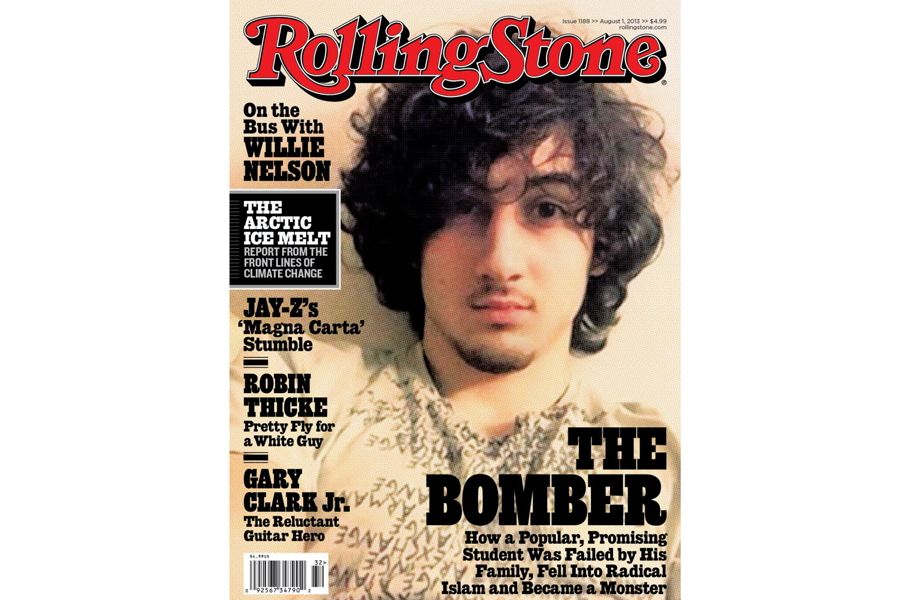Tsarnaev on Rolling Stone cover: Rock-star treatment or good journalism?
Loading...
| Los Angeles
Rolling Stone’s decision to feature Boston Marathon bombing suspect Dzhokhar Tsarnaev on its Aug. 1 cover has kicked up a social media and real world dust storm.
Facebook and the Twittersphere are surging with commentary, most of which – though not all – condemns what many are calling a glamorous, introspectively poetic photo that gives celebrity-style treatment to a terrorism suspect.
Indeed, the image is lifted from Mr. Tsarnaev’s own social media page – and if Facebook had existed when Bob Dylan was a teen, this could easily have been his self-portrait.
In Boston, both Tedeschi Food shops and CVS have announced they will not sell the issue.
In the bottom right corner of the cover, the headline reads: “The Bomber: How a Popular, Promising Student Was Failed by his Family, Fell Into Radical Islam and became a Monster.”
If you flip to page 46, the story begins soberly enough: “He was a charming kid with a bright future. But no one saw the pain he was hiding or the monster he would become.”
The problem with the story, say the critics, is that what many consider the disastrous effects of romanticizing evil have already happened, long before anyone flips into the actual magazine piece.
A statement released by Rolling Stone Wednesday defended the story as “within the traditions of journalism and Rolling Stone's long-standing commitment to serious and thoughtful coverage of the most important political and cultural issues of our day.” However the statement did not directly address characterizations of Tsarnaev’s cover image.
Giving Tsarnaev rock-star status by featuring him on the cover is dangerous, says Los Angeles psychiatrist, Carole Lieberman, author of “Coping with Terrorism: Dreams Interrupted.”
“This will provoke wannabe terrorists to commit similar acts, so that their picture will be on the cover, as well,” she says.
Most important, Rolling Stone appeals to a counter-culture demographic, notes Dr. Lieberman, which includes “people who think it's cool to topple authority figures and the status quo, a population that could well give birth to the next domestic terrorist.”
The headline is actually more troubling than the photo, says Carolyn Kitch, a professor of journalism at Temple University in Philadelphia. It suggests a tragic fall, she says, a standard, recognizable storyline, “the fall-from-grace story: How could it be that this promising young man was led astray?”
Interestingly, she notes via e-mail, “that is also the plotline for the story of the young man who is on the cover of People magazine this week: Cory Monteith, the Glee star who died of a drug overdose.” This is a typical narrative template for the dead-rock-star story, she says, but in the case of the Rolling Stone coverline, it narratively enfolds Tsarnaev himself within the tragedy.
But there are many, many examples of outrageous figures gracing the covers of magazines, from Adolf Hitler to Charles Manson, says journalism professor Mark Tatge, from DePauw University in Green Castle, Ind.
“The role of media is to inform and provide context for events. To the extent that this story gives us more information about this horrible tragedy, it is valuable,” he says via e-mail, adding that hopefully stories like these will only improve our understanding of what went wrong here so future incidents like these can be avoided. “Choking off or censoring stories like these is not the solution to the problem, nor does it help us move forward as a society,” Professor Tatge adds.
Doug Spero, professor of mass communication at Meredith College, in Raleigh, N.C., agrees that this is nothing new.
“I am a guy of journalistic ethics, and from what I am reading here, this looks like solid journalism,” he says via e-mail. People want to know what was in the mind of a Lee Harvey Oswald, he says, adding that there is a place for something like this “as long as it doesn’t become tabloid journalism.”
This is the kind of stuff that books are written about, adds Professor Spero, why not a magazine?
But comparisons to magazine covers featuring such historical evil-doers as Osama bin Laden miss the mark, suggests Brian Heffron, a former journalist and now Boston public relations professional.
“This feels very different than, say, a cover story of bin Laden in Time,” he says, adding that whether it is the style of the photo or the simple fact that it's on Rolling Stone, “it seems to glorify this alleged terrorist. The magazine seems to be romanticizing him as a James Dean rebel and not profiling a mass murderer.”
Let's face it, says Mr. Heffron, “the editors knew full well the controversy will grab attention” from its target demographic.
The magazine’s statement Wednesday addressed that point. “The fact that Dzhokhar Tsarnaev is young, and in the same age group as many of our readers, makes it all the more important for us to examine the complexities of this issue and gain a more complete understanding of how a tragedy like this happens."
The question, continues Heffron, will be, is the vitriol balanced by interest in buying the issue for the story?
The answer to that question is simple for psychiatrist Lieberman. It matters little what has been written about Tsarnaev within the magazine, she says, since many will just see the cover “and it will set their minds spinning, trying to figure out how they can become an immortalized 'hero' like Tsarnaev.”





